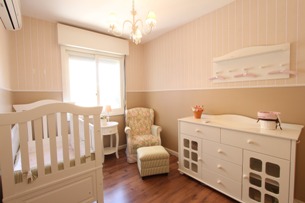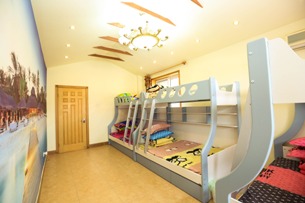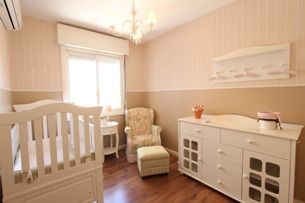What color to choose to make the kids happy and like their room even as they get older? Tasteful variations of vibrant color will amaze your kids and stimulate their imagination. If you insist on neutral white, always use lively accessories. When selecting the dominant color, pay attention to the character and feelings of your child, and always buy a healthy color!



Still in doubt? Get inspired by some ideas of the world’s best interior designers on how to transform the children’s room into a kingdom of games, fun, and relaxation.
Use three colors at most
Kids love bright colors and expressive decorations. Their room should reflect their spontaneity. But be careful, don’t get carried away, and stick to the maximum of three colors! A too great diversity of shades creates chaos which might affect the child’s psyche.
Who will live in the room?
To make the children happy, their room should reflect their personality. If they are rather shy, use fine bright tones; extrovert rogues, on the other hand, will prefer rich colors with bright furniture and accessories.
My room, my castle
During the day, the children’s room should be full of light. At night, it should provide sufficient peace for undisturbed sleep. For small children, avoid strong color contrasts of white and black which might seem scary in the dark. Still don’t know which color is the right one? If the children don’t tell you what they prefer, try spreading a couple of their drawings on the floor. Which color seems to prevail?
If you meet the children’s taste, the new space will become their favorite retreat, a place where they’ll be happy to play, spend their free time and have a rest. Choose only safe, natural, odorless, and hazardous colors.
Colors preferred by girls
Pink may sound like a cliché, but it works in most cases. It can offer many shades and combinations with other colors, depending on the child’s age. The intensity of the pink walls might be softened with light, preferably white floors and furniture.
Be careful with red color though. Too bright a shade might seem too menacing or scary to the child. On the contrary, the darker red, accompanied with a red bed cover or red window curtains, creates a warm and pleasant atmosphere.
If you choose dark colors, make sure there are enough toys and fun stuff to create a good mood.
Boys’ den in blue?
Navy blue in several shades invites you to use strips and white elements. You can combine it with brown furniture and white upholstery. Soft blue is popular with girls, as well – it can be easily combined with pink, coral red or green until they are in their teens.
A softer variant of bright shades of blue and gray can induce a relaxing atmosphere.
Don’t be afraid of orange
The orange color is perfect for older children who are not in their teens yet. It’s suitable for both girls and boys, so it can be a great solution for shared rooms. Orange matches black, white and gray elements. Its pervasiveness can be softened with a shade of blue. A combination of orange and yellow accessories is popular, too.
Last, but not least, think about the furniture
If the walls and floor (or carpet) are of the same color, it’s easy! Find some furniture and decorations in the same style. Cabinets, desk and shelves with identical multicolor doors can create a nicely designed room.
Don’t you feel like experimenting? Play with the accessories! A room with white walls can be livened up with colorful shelves, bedheads, storage spaces, or padding. What if you combined orange and green? These colors look very elegant on a white background.
When arranging the children’s room, however, follow the simple rule: never buy the dominant furniture pieces separately; all pieces should be in harmony! Remember that your children’s taste can be formed from an early age.
Photo – source: Pixabay.com





